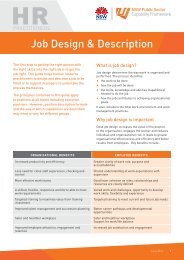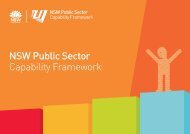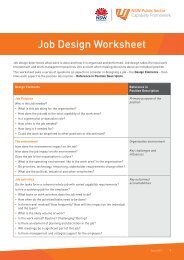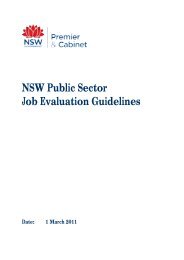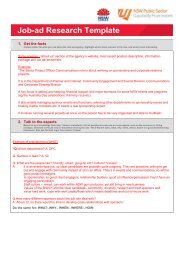Developing Selection Criteria - NSW Public Sector Capability ...
Developing Selection Criteria - NSW Public Sector Capability ...
Developing Selection Criteria - NSW Public Sector Capability ...
You also want an ePaper? Increase the reach of your titles
YUMPU automatically turns print PDFs into web optimized ePapers that Google loves.
HR<br />
Practitioners<br />
<strong>Developing</strong> <strong>Selection</strong> <strong>Criteria</strong><br />
The public sector’s capacity to achieve its<br />
business objectives depends on the capability of<br />
the people who work for it, how well equipped<br />
they are to perform their roles and their fit with<br />
organisational culture.<br />
The first challenge is to attract and select the<br />
right staff.<br />
This guide focuses on attracting and matching<br />
the right person with the right skills to the right<br />
job, by:<br />
• setting selection criteria that reflect position<br />
needs and labour market realities<br />
• communicating effectively with potential<br />
applicants through the advertisement and<br />
information package, and<br />
• making the recruitment process more<br />
accessible for job applicants.<br />
This critical first stage of the recruitment<br />
process will, to a very large extent, shape the<br />
final recruitment outcome.<br />
What are selection criteria?<br />
<strong>Selection</strong> criteria are benchmarks for selection, the<br />
factors against which applicants are assessed to<br />
determine their relative suitability for the position.<br />
They comprise knowledge, skills, abilities and other<br />
specific requirements such as specialised subject<br />
expertise, qualifications, physical requirements<br />
and licences needed to undertake the duties of the<br />
position successfully.<br />
<strong>Selection</strong> criteria are mandatory for recruitment to<br />
<strong>NSW</strong> public sector jobs because they:<br />
• make the selection process more transparent<br />
• make the selection process more equitable to<br />
people who are not familiar with the job being<br />
advertised, taking the guesswork out of what to<br />
focus on in the application<br />
• provide a sound platform for the structured<br />
interviews commonly used for selection<br />
• make it easier for selection panels to shortlist and<br />
rank applicants on merit, especially when there are<br />
large numbers of applicants.<br />
<strong>Selection</strong> criteria are developed from the position<br />
description and are designed to reflect the needs<br />
of the position. They should be expressed clearly,<br />
concisely and in plain English to maximise the number<br />
of suitable applicants.<br />
Potential applicants must be advised of the criteria<br />
against which they will be assessed. This information<br />
may be presented in different ways in the job<br />
advertisement.<br />
March 2011 1
Vacant position = opportunity<br />
Recruitment in the <strong>NSW</strong> public sector is positionbased<br />
to provide a transparent basis for merit<br />
recruitment.<br />
Positions are linked to organisational objectives and<br />
described in terms of outcomes/accountabilities,<br />
capabilities or knowledge, skills and abilities, and<br />
other requirements needed to perform effectively in<br />
the role. Values and behaviours expected of public<br />
sector employees are integrated into the capabilities.<br />
Roles within an organisation are dynamic: they change<br />
and evolve in response to changes in the organisation<br />
and the operating environment, legislation, policy or<br />
technology.<br />
A vacant position, whether it is the result of the<br />
incumbent winning another position, retirement,<br />
resignation or a newly established position, presents<br />
an opportunity to review the position from a broader<br />
workforce planning perspective. This involves<br />
reviewing current and future work needs and<br />
considering such questions as:<br />
• how does the work fit within the agency’s corporate<br />
plan?<br />
• is the work essential to the operation of the work<br />
area and/or the agency?<br />
• could the work be dispersed to other positions or<br />
discontinued?<br />
• what would be the best way to structure the work?<br />
• what would be the best way to deliver it?<br />
• if the work needs are changing, what action is<br />
needed to address the changes?<br />
• is this the right time to recruit?<br />
• what is the best employment option?<br />
The decision to recruit should be a trigger for updating<br />
the position description if necessary.<br />
This process may be controlled centrally in agencies<br />
that use common position descriptions and selection<br />
criteria for positions located throughout the<br />
organisation or the state.<br />
For positions managed on a unit basis it is important<br />
for the manager and/or person responsible for<br />
developing the selection criteria and advertisement<br />
to look afresh at the job and not to be bound by<br />
outdated position descriptions, the selection criteria<br />
used previously, old advertisements or the particular<br />
strengths or experience of the person most recently<br />
occupying the position.<br />
Useful reference material<br />
• A range of employment options are described in Chapter 2 of the Personnel Handbook at<br />
www.dpc.nsw.gov.au<br />
• Guidelines, templates and tools are available on the <strong>NSW</strong> <strong>Public</strong> <strong>Sector</strong> Capabilities Website,<br />
www.pscapabilities.nsw.gov.au to assist in updating the position description if required. These include:<br />
– Job Design & Description Guidelines<br />
– Position Description Template and Guide<br />
– Job Design Worksheet<br />
– Online Position Description Builder<br />
– <strong>NSW</strong> <strong>Public</strong> <strong>Sector</strong> <strong>Capability</strong> Framework<br />
• <strong>Developing</strong> <strong>Selection</strong> <strong>Criteria</strong> for Managers<br />
– a slightly shortened version of the HR Practitioners guide.<br />
March 2011 2
Understanding the job<br />
Recruitment represents a significant investment by<br />
the agency, not just in terms of the time, effort and<br />
other costs associated with the recruitment process<br />
but in the larger, ongoing costs of employing and<br />
managing the person appointed. Recruiting the right<br />
person adds value to the agency. Recruiting the<br />
wrong person can have major adverse impacts on the<br />
position and the team.<br />
Tailoring the job advertisement and selection process<br />
to reflect the job needs will achieve the best fit<br />
between the recruitment action and the position.<br />
A clear understanding of the job assists:<br />
• the manager or selection convenor to set the<br />
selection criteria, write the job advertisement,<br />
develop interview questions, and assess the best<br />
applicant for the job<br />
• potential job applicants to decide if they should<br />
apply for the job and to prepare for selection<br />
processes.<br />
General principles for setting<br />
selection criteria<br />
The pool of applicants attracted by the advertisement<br />
will be determined to a large extent by the selection<br />
criteria. It is crucial that the criteria accurately reflect<br />
the requirements of the position and that they are able<br />
to attract a sufficiently wide pool of applicants.<br />
When setting selection criteria:<br />
• focus on the key requirements of the job, although<br />
organisational and strategic considerations may<br />
also be taken into account<br />
• capture the critical aspects of the job in no more<br />
than eight criteria, and preferably in just four to<br />
six criteria. A larger number of selection criteria<br />
deters applicants and makes the assessment<br />
process more complex<br />
• give careful consideration to how specific or how<br />
broad the selection criteria should be<br />
• include only one requirement per criterion: not<br />
multiple concepts or requirements<br />
• explain the level of capability or type of experience<br />
that is required<br />
• use language that would be understood by people<br />
from the industry targeted<br />
• avoid public sector terminology, acronyms, jargon<br />
or agency specific terms<br />
• use precise language to describe what is required<br />
by the job, rather than vague terms such as ’high<br />
level’, ’exceptional’ etc<br />
• only include criteria that are key to undertaking<br />
the accountabilities of the position, not ’highly<br />
regarded’, ‘preferred’ or ‘desirable’ criteria<br />
• be clear and succinct<br />
• include qualifications only if they are an essential<br />
requirement of the job, to ensure that applicants<br />
are not unnecessarily excluded<br />
Factors to consider in setting<br />
selection criteria<br />
1. How broad or specific should the selection<br />
criteria be?<br />
Applicants usually decide to apply for the job on<br />
the basis of the criteria. Broad criteria generally<br />
attract a wider pool of applicants, but criteria<br />
that are too broad make it difficult to distinguish<br />
applicants who best fit the job.<br />
2. What is the labour market like for this type of<br />
position?<br />
If there is a large employment pool of suitably<br />
qualified applicants the selection criteria can<br />
be very specific and demanding. If potential<br />
applicants are scarce, the criteria may need to be<br />
broader or even pitched at a lower level, which<br />
means training may be required.<br />
3. Location?<br />
Jobs in some locations are highly sought after,<br />
while others are hard to fill, regardless of how<br />
many suitable people are in the labour market.<br />
Better work conditions, incentives or alternative<br />
ways of meeting job requirements may need to be<br />
considered for jobs in some locations.<br />
4. Are there specific organisational needs to<br />
be met?<br />
The selection criteria should be focused on the job<br />
but specific organisational needs may need to be<br />
considered. For example, a position description<br />
may include several skills, knowledge and<br />
experience requirements, one of which is a skills<br />
gap for the team. This requirement could be a<br />
strong focus when setting the selection criteria.<br />
March 2011 3
5. What are the immediate and longer term needs<br />
of the position?<br />
If this is a short term position, with limited work<br />
and funding, it makes sense to recruit for the skills<br />
needed immediately. Broader criteria may be<br />
appropriate if the position is permanent or likely to<br />
change or if the appointee has prospects of moving<br />
on to other roles in the organisation in the longer<br />
term.<br />
6. What qualifications and other requirements<br />
should be included as criteria?<br />
Mandatory requirements<br />
Many positions have mandatory requirements, for<br />
example:<br />
• physical requirements such as height, vision,<br />
hearing or fitness standards for police officers,<br />
fire brigade personnel etc<br />
• registration, certification,licensing, tertiary<br />
qualifications or professional memberships e.g.<br />
clinicians, auditors, solicitors, welders<br />
• drivers licences<br />
• ability/willingness to travel<br />
These may be specified in various forms including<br />
legislation, industrial awards, Department of<br />
Premier and Cabinet Circulars or in the position<br />
description. Such requirements should be<br />
assessed for direct or indirect discrimination<br />
before they are included as selection criteria.<br />
Where possible, alternatives to tertiary<br />
qualifications should be considered as evidence of<br />
competence, for example work experience or work<br />
samples.<br />
Identified and targeted positions<br />
For identified and targeted positions, include that<br />
the candidate must be a member of an identified<br />
disadvantaged group as a selection criterion.<br />
Note that an exemption from the Anti-<br />
Discrimination Act 1977 may be needed for<br />
targeted positions where they have not been<br />
identified as a strategy in the agency EEO<br />
Management Plan.<br />
Subject/technical knowledge and experience<br />
The capabilities described in the <strong>NSW</strong> <strong>Public</strong><br />
<strong>Sector</strong> <strong>Capability</strong> Framework capture underlying<br />
skills, knowledge and abilities that are either<br />
integral to all jobs in the sector or that are required<br />
in many public service positions. However, the<br />
capabilities are broad and many positions also<br />
have specific subject/technical knowledge and<br />
experience requirements, such as accounts work,<br />
asset management, media skills or aged care.<br />
The relevant capabilities and/or specific<br />
knowledge/experience requirements may be<br />
included as selection criteria.<br />
Years of experience<br />
It is preferable not to be too rigid in prescribing<br />
years of experience. Practical application of skills<br />
is important for developing skill levels, but there<br />
is a point beyond which more experience does not<br />
necessarily add significantly to performance.<br />
As with all stated requirements, qualifications<br />
must be strictly job related.<br />
March 2011 4
Writing the selection criteriaStep<br />
Step 1 Use the selection criteria worksheet to<br />
identify and prioritise selection criteria<br />
• <strong>Selection</strong> <strong>Criteria</strong> Worksheet<br />
• <strong>Selection</strong> <strong>Criteria</strong> Worksheet – Tips<br />
Step 2 Consolidate<br />
1) Start a new list with the selection criteria<br />
2) Rationalise the list, especially if there are more<br />
than 8 criteria.<br />
Check if:<br />
• the criteria are duplicated<br />
• the criteria are too narrow e.g. ability to write<br />
reports rather than the broader capability of<br />
communication<br />
• the criteria may be ranked in order of<br />
importance<br />
Step 3 Write the selection criteria<br />
Draft the criteria for advertisement, following the<br />
General principles for setting selection criteria on<br />
page 3 of this guide. Then check your draft using the<br />
<strong>Selection</strong> <strong>Criteria</strong> Quality Checklist.<br />
If the information package includes a position<br />
description that uses the public sector capabilities and<br />
levels you should add the following statement in the<br />
advertisement:<br />
Please note that the selection process only<br />
requires you to respond to the selection criteria<br />
above, not to the full range of capabilities listed<br />
in the position description.<br />
Using public sector capabilities in<br />
developing selection criteria<br />
The <strong>NSW</strong> <strong>Public</strong> <strong>Sector</strong> <strong>Capability</strong> Framework<br />
(PSCF) is a useful resource for a range of workforce<br />
management activities, including recruitment, it:<br />
• allows for more precise description of<br />
capabilities and capability levels than traditional<br />
generalisations like ’high level’ or ’excellent’<br />
• supports a behavioural approach in selection<br />
criteria and interview questions which taps into<br />
the applicants’ abilities, actual experience and<br />
attitudes.<br />
Capabilities and capability levels drawn from the<br />
PSCF will progressively replace descriptions of<br />
’key skills, knowledge and experience’ in position<br />
descriptions. The capabilities describe broad generic<br />
skills, knowledge and abilities that are commonly<br />
required across the public sector. They do not cover all<br />
capabilities, nor replace all selection criteria, as some<br />
jobs may require specialised content knowledge, skills<br />
and experience.<br />
When formulating selection criteria you need to<br />
consider the whole of the position description: the<br />
‘key outcomes/accountabilities’ and ‘key challenges’<br />
as well as the ‘capabilities’. In some cases, broad<br />
capabilities will be enough to select the person you<br />
need for the job; in others you will need to be more<br />
specific in your selection criteria.<br />
<strong>Capability</strong> levels should NOT be quoted in selection<br />
criteria or job advertisements.<br />
Giving candidates several pages of behavioural<br />
indicators or a link to the <strong>Capability</strong> Framework with<br />
instructions to interpret and apply this information<br />
when preparing a job application is likely to:<br />
• overwhelm candidates, particularly those who are<br />
not knowledge-workers<br />
• perpetuate the impression that applying for public<br />
sector jobs is very complex<br />
• discourage potential candidates from applying for<br />
the job<br />
Ways that the capabilities may be used in selection<br />
criteria<br />
1. Quoting directly from the <strong>NSW</strong> <strong>Public</strong> <strong>Sector</strong><br />
<strong>Capability</strong> Framework, with minor editing to<br />
sharpen the text. The quote could be a title, all or<br />
part of a capability description or a behavioural<br />
indicator.<br />
2. Modifying a capability or behavioural indicator to<br />
focus on the specific requirements of the position.<br />
3. Writing your own selection criteria, using the<br />
appropriate capability and behavioural indicators<br />
as a model so that the language and level are right<br />
for the position.<br />
4. Combining related capabilities. This means putting<br />
like with like, not putting two unrelated capabilities<br />
into a single criterion.<br />
March 2011 5
EXAMPLE 1<br />
Position Title<br />
Key Outcome / Accountability<br />
<strong>Capability</strong><br />
Customer Service Officer, Accommodation<br />
Respond to customer service enquiries via email, phone and face-toface,<br />
assessing client needs, providing information and resolving service<br />
problems to achieve customer satisfaction.<br />
Customer focused: Keeps the customer (internal or external) as the focal<br />
point of all activity; strives to address customer needs and concerns.<br />
Helps customers (and business partners) to achieve their goals through<br />
the application of own skills, behaviours and knowledge.<br />
Element & level Demonstrates service orientation Level 2<br />
Relevant behavioural indicators<br />
<strong>Selection</strong> criteria<br />
Direct quote with minor editing<br />
Modify to focus on specific<br />
requirement<br />
Write your own<br />
Combining related capabilities/<br />
indicators (Customer focused Level<br />
2, Solves Problems Level2)<br />
• Interprets customer needs in providing quality<br />
customer service<br />
• Focuses on customer satisfaction<br />
The successful applicant will be….<br />
Customer focused. You strive to address customer needs and concerns.<br />
Focused on providing quality customer service to address customer<br />
accommodation needs and concerns.<br />
Committed to good customer service and able to understand and satisfy<br />
customer needs.<br />
Able to understand customer service needs and resolve day-to-day<br />
problems.<br />
EXAMPLE 2<br />
Position Title<br />
Key Outcome / Accountability<br />
<strong>Capability</strong><br />
Senior Performance Analyst<br />
Mine operational and financial data to identify blockages in organisational<br />
performance, analyse the causes and develop solutions.<br />
Analytical thinking and problem solving: Identifies and analyses situations<br />
and/or issues, considers options, develops solutions, and decides on,<br />
implements and monitors appropriate solutions.<br />
Element & level Undertakes analysis Level 4<br />
Relevant behavioural indicators<br />
<strong>Selection</strong> criteria<br />
Direct quote with minor editing<br />
Modify to focus on specific<br />
requirement<br />
Write your own<br />
Combining related capabilities/<br />
indicators (Undertakes analysis<br />
Level 4, Influences and negotiates<br />
Level 2)<br />
Applies sophisticated information and data analysis techniques<br />
Identifies likely causes and consequences<br />
The successful applicant will demonstrate the ability to:<br />
Apply sophisticated information and data analysis techniques<br />
Apply sophisticated information and data analysis techniques to identify<br />
performance blockages<br />
Mine organisational data using sophisticated information and data<br />
analysis techniques<br />
Use sophisticated analysis and convincing presentation of information to<br />
influence management action.<br />
March 2011 6
EXAMPLE 3<br />
Position Title<br />
Key Outcome / Accountability<br />
<strong>Capability</strong><br />
Element & level<br />
Relevant behavioural indicators<br />
<strong>Selection</strong> criteria<br />
Direct quote with minor editing<br />
Modify to focus on specific<br />
requirement<br />
Write your own<br />
Combining related capabilities/<br />
indicators (including information<br />
from: Understands business basics,<br />
Level 6)<br />
Manager, Corporate Communications<br />
Lead the planning, development, design and other work required to<br />
develop and maintain the organisation’s unique brand through marketing<br />
material, signage, presentation, web and other work.<br />
Commercial Acumen: Builds and maintains a wide knowledge and<br />
understanding of the business environment and applies commercial<br />
expertise including concepts, processes and strategies to achieve<br />
business objectives.<br />
Applies commercial and general financial and economic knowledge at<br />
Level 6<br />
Understands and applies strategies and techniques to differentiate and/or<br />
promote the services of the organisation<br />
The successful applicant will demonstrate the ability to:<br />
Understand and apply strategies and techniques to promote the services<br />
of the organisation<br />
Understand and apply marketing strategies and techniques to promote the<br />
organisation’s brand and identity<br />
Lead innovative marketing management including brand development,<br />
direct marketing and e-commerce media campaigns<br />
Identify key business success drivers to determine effective marketing<br />
strategies and techniques to promote the organisation’s brand and identity<br />
EXAMPLE 4<br />
Position Title<br />
Key Outcome / Accountability<br />
<strong>Capability</strong><br />
Registered Nurse<br />
Communicates sensitively with patients / clients using interpersonal skills<br />
to identify their needs and advocate on behalf of patients/clients and their<br />
families as and when required.<br />
Client Engagement: Identifies and anticipates the needs of clients,<br />
delivers services that meet and exceed client expectations and commits<br />
to continuous improvements in planning, process and services.<br />
Element Demonstrates professional empathy at Level 2<br />
Relevant behavioural indicators<br />
<strong>Selection</strong> criteria<br />
Direct quote with minor editing<br />
Modify to focus on specific<br />
requirement<br />
Write your own<br />
Combining related capabilities/<br />
indicators (Demonstrates service<br />
orientation level 2, Demonstrates<br />
professional empathy level 2)<br />
Applies appropriate sensitivity and interpersonal skill to manage<br />
interactions and effectively advocate for client outcomes.<br />
The successful applicant will...<br />
Use appropriate sensitivity and interpersonal skill to manage interactions<br />
and effectively advocate for client / patient outcomes<br />
Use appropriate sensitivity and interpersonal skill to manage interactions and<br />
effectively advocate to achieve individual clinical outcomes for clients/patients,<br />
Communicate sensitively to identify needs and advocate for patients/<br />
clients to achieve individual clinical outcomes.<br />
Build trust with clients/patients by being honest and apply appropriate<br />
sensitivity and interpersonal skills to manage interactions and effectively<br />
advocate for client/patient outcomes<br />
March 2011 7
Deciding what selection methods<br />
to use<br />
<strong>Selection</strong> methods and selection criteria are interrelated.<br />
<strong>Selection</strong> methods are the tools and techniques used<br />
to measure a candidate’s performance against the<br />
selection criteria.<br />
<strong>Selection</strong> panels are encouraged to consider a range<br />
of methods for assessing and selecting the most<br />
meritorious applicant. Different selection methods<br />
work better for different kinds of work. Combining<br />
a number of different methods may increase the<br />
predictive validity of the selection.<br />
The selection method chosen will depend on the<br />
selection criteria. There is no point in setting a<br />
selection criterion that cannot be assessed effectively.<br />
Job applications<br />
It has been standard practice for many years in <strong>NSW</strong><br />
public sector agencies to ask applicants to submit<br />
a written statement addressing each of the listed<br />
selection criteria with their application. There is no<br />
legislative or policy requirement to do so. Rather, this<br />
practice may pose a barrier to effective recruitment.<br />
Agencies are encouraged to<br />
• invite applicants to address the selection criteria<br />
either by submitting a written statement of claim<br />
addressing each criterion, or by providing sufficient<br />
detail in their covering letter and resumé to show<br />
how they meet the criteria<br />
• set limits on applicant responses (e.g. a 300 word<br />
limit for responses to individual selection criteria if<br />
an applicant chooses to make a statement of claim,<br />
a one page covering letter and a three page limit<br />
for resumés)<br />
e-Recruitment pre-screening questions<br />
A pre-screening question function is available in<br />
the e-Recruitment system. This function allows<br />
questions to be asked and answered online as part of<br />
the application process, resulting in a more efficient<br />
recruitment process. Pre-screening questions can:<br />
• be used to filter mandatory and other yes/no<br />
responses, rather than having the applicant<br />
include the response in the cover letter or claim for<br />
the position.<br />
• be used for multiple-choice type responses<br />
For example, the question could list a number of<br />
software applications with a range of skill levels,<br />
and ask the applicant to identify their skill level for<br />
each application.<br />
• ask for a narrative text response.<br />
For example, asking an applicant to provide further<br />
explanation or examples of their skills or experience<br />
against a specific selection criterion.<br />
While text or narrative responses cannot be scored<br />
by the e-Recruitment system it can help the hiring<br />
manager to draw the information from the applicant,<br />
without the need for a lengthy statement.<br />
The system may assist selection panels to shortlist<br />
applications by automatically sorting applications on<br />
the basis of the pre-screening questions. <strong>Selection</strong><br />
panels must still verify that applications have been<br />
sorted correctly.<br />
Contact the e-recruitment consultant in your agency<br />
for further information on the pre-screening capabilities<br />
of the <strong>NSW</strong> public sector e-Recruitment system.<br />
Advising applicants<br />
Potential applicants should be clearly informed about the:<br />
• selection criteria against which their application<br />
will be assessed<br />
These should be clearly stated in the advertisement.<br />
• way in which they are to address the selection<br />
criteria in their job application<br />
For example, if they:<br />
– can address the selection criteria in their<br />
covering letter or in a resumé<br />
– need to submit a written statement addressing<br />
each criterion separately<br />
– are required to apply for the job online<br />
– have to attach the information in a separate<br />
document<br />
These instructions may be presented in different<br />
ways, such as in the job advertisement or in the job<br />
information package.<br />
Copyright © 2011 Department of Premier and Cabinet<br />
The Department has no objection to this document being copied, in whole or in part, provided there is due acknowledgement of any material quoted from it.<br />
<strong>Public</strong> <strong>Sector</strong> Workforce | Department of Premier and Cabinet<br />
T: (02) 9228 4444 | F: (02) 9228 3522 | E: workforceplanning@dpc.nsw.gov.au | W: www.pscapabilities.nsw.gov.au<br />
March 2011 8




